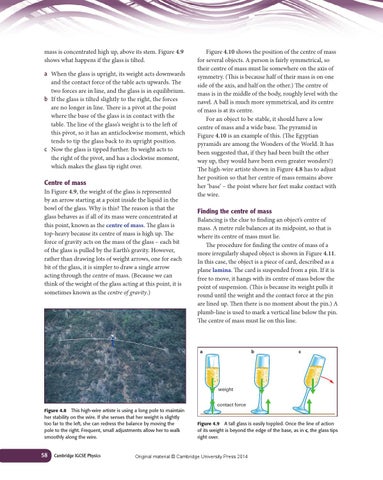mass is concentrated high up, above its stem. Figure 4.9 shows what happens if the glass is tilted.
a When the glass is upright, its weight acts downwards and the contact force of the table acts upwards. The two forces are in line, and the glass is in equilibrium. b If the glass is tilted slightly to the right, the forces are no longer in line. There is a pivot at the point where the base of the glass is in contact with the table. The line of the glass’s weight is to the left of this pivot, so it has an anticlockwise moment, which tends to tip the glass back to its upright position. c Now the glass is tipped further. Its weight acts to the right of the pivot, and has a clockwise moment, which makes the glass tip right over.
Centre of mass In Figure 4.9, the weight of the glass is represented by an arrow starting at a point inside the liquid in the bowl of the glass. Why is this? The reason is that the glass behaves as if all of its mass were concentrated at this point, known as the centre of mass. The glass is top-heavy because its centre of mass is high up. The force of gravity acts on the mass of the glass – each bit of the glass is pulled by the Earth’s gravity. However, rather than drawing lots of weight arrows, one for each bit of the glass, it is simpler to draw a single arrow acting through the centre of mass. (Because we can think of the weight of the glass acting at this point, it is sometimes known as the centre of gravity.)
Figure 4.10 shows the position of the centre of mass for several objects. A person is fairly symmetrical, so their centre of mass must lie somewhere on the axis of symmetry. (This is because half of their mass is on one side of the axis, and half on the other.) The centre of mass is in the middle of the body, roughly level with the navel. A ball is much more symmetrical, and its centre of mass is at its centre. For an object to be stable, it should have a low centre of mass and a wide base. The pyramid in Figure 4.10 is an example of this. (The Egyptian pyramids are among the Wonders of the World. It has been suggested that, if they had been built the other way up, they would have been even greater wonders!) The high-wire artiste shown in Figure 4.8 has to adjust her position so that her centre of mass remains above her ‘base’ – the point where her feet make contact with the wire.
Finding the centre of mass Balancing is the clue to finding an object’s centre of mass. A metre rule balances at its midpoint, so that is where its centre of mass must lie. The procedure for finding the centre of mass of a more irregularly shaped object is shown in Figure 4.11. In this case, the object is a piece of card, described as a plane lamina. The card is suspended from a pin. If it is free to move, it hangs with its centre of mass below the point of suspension. (This is because its weight pulls it round until the weight and the contact force at the pin are lined up. Then there is no moment about the pin.) A plumb-line is used to mark a vertical line below the pin. The centre of mass must lie on this line.
a
b
c
weight contact force Figure 4.8 This high-wire artiste is using a long pole to maintain her stability on the wire. If she senses that her weight is slightly too far to the left, she can redress the balance by moving the pole to the right. Frequent, small adjustments allow her to walk smoothly along the wire.
58
Cambridge IGCSE Physics
Figure 4.9 A tall glass is easily toppled. Once the line of action of its weight is beyond the edge of the base, as in c, the glass tips right over.
Original material © Cambridge University Press 2014
